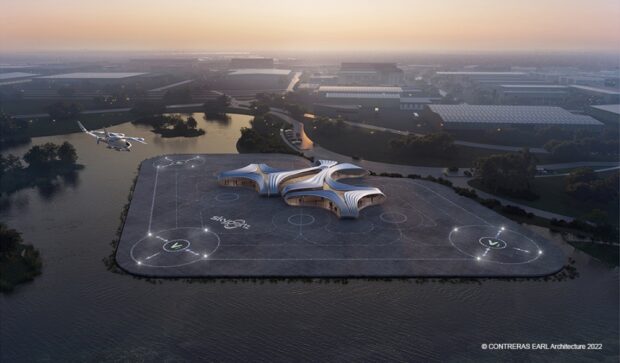Skyportz announced the design for the first vertiport in Australia to service the emerging electric air taxi industry at the AAUS annual Advanced Air Mobility summit in Melbourne.
The vertiport will be located at Caribbean Park in Melbourne’s east, the fastest growing business precinct outside of the Melbourne CBD.
Caribbean Park and Skyportz have worked with Contreras Earl Architects, to70 aviation, ARUP and Microflite to come up with a practical, modular design to satisfy operational requirements to operate as a vertiport for Advanced Air Mobility.
“With the development of a vertiport in a business park we are breaking the nexus between aviation and airports. For this industry to succeed it needs to have policy makers pushing the envelope to support new “mini airports” in locations people want to go”,
said Clem Newton-Brown, CEO of Skyportz.
“However community support is going to be the key to the development of these services. The community is going to have to see the benefits”
“Electric air taxis will be a new era in aviation where clean, green and quiet small aircraft can take people to places they want to go – be it work or leisure. The Caribbean Park vertiport is the first in a network of sites we will establish in advance of the aircraft becoming operational”
said Newton-Brown.
The Federal regulator, CASA recently released a roadmap for the introduction of Advanced Air Mobility to Australia and various States are also trying to attract the investment which will flow from being a frontrunner in this new aviation industry.
It is anticipated that some eVTOL aircraft will be commercially in the coming years, with some timelines including 2024 for limited initial passenger carrying flights. There are over 300 designs in development and the frontrunners are already flying prototypes.
Skyportz will be seeking investment partners to fund the construction of the vertiport at Caribbean Park which will be the first in a stable of vertiports strategically located around Australia.
Why it’s important: Skyportz’ approval for usage of Melbourne’e east location is a milestone step along the path for the company to now shift focus to obtaining funding and construction partners for the project. The location will support the Melbourne urban area’s commuting requirements, and the project’s success is largely contingent on efficiently linking to other facets of the transportation system. This includes the Melbourne International Airport as well as other tertiary cities nearby, such as Geelong, and the viability of repurposing helicopter landing pads to create a network of eVTOL routes that will supplant a main hub in Melbourne.
Source: Transport Up

